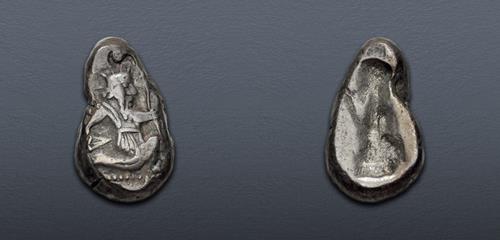|
PERSIA, Achaemenid Empire. temp. Darios II to Artaxerxes II. Circa 420-375 BC. AR Siglos (12mm, 5.94 g). Lydo-Milesian standard. Sardes or subsidiary mint. Persian king or hero, wearing kidaris and kandys, quiver over shoulder, in kneeling-running stance right, holding dagger in right hand, bow in left; pelleted ground line below / Incuse punch. Carradice Type IV, Group B (pl. XIV, 43); cf. Meadows, Administration 326 (Type IV, Group C); BMC Arabia pl. XXVII, 10; Sunrise –. Deeply toned with iridescence, banker’s mark on obverse. Good VF.
From the DSV Collection. Ex Rosenblum 33E (11 December 2003), lot 224.
During the Wars of the Delian League (477-449 BC), the Persians was beset by several internal problems. Among these were revolts that broke in various parts of their empire. Of particular importance was a revolt in Egypt led by the rebel Inaros (circa 460 BC). With Athenian aid, Inaros defeated and slew the Persian satrap Achaimenes at the Battle of Papremis (459 BC). Eventually, the Athenians were defeated and Inaros was captured and sent to Susa for execution.
Following the death of Artaxerxes I in 424 BC, the throne was challenged by two brothers – Xerxes II and Sogdianus – who together ruled for less than a year. Their illegitimate brother, Ochos, succeeded them as Darios II. Although he ruled for 21 years and attempted to expel several of the Greek dynasts in Ionia – including the sons of Themistokles – Darios was most notable for instituting the power struggle for the throne following his death in 404 BC. When his older son, Artaxerxes II, took the throne, the younger, Cyrus, rebelled with various Greek mercenaries, known collectively as the Ten Thousand, including the Athenian, Xenophon. These events are recorded in his work, the Anabasis.
Following his defeat of his younger brother, the rest of Artaxerxes' reign was plagued with Persian involvement in the affairs of the Greeks, as well as internal rebellions. The revolt of Evagoras in Cyprus (391-390 BC) proved inconclusive, and Evagoras remained as a Persian vassal. The most important revolt was that of the western satraps. Known as the Great Satraps' Revolt (360s-350s BC), it involved several of the powerful Anaolian satraps (Datames, Ariobarzanes, Orontes, and Maussolos of Caria) and their Egyptian pharaonic allies (Nectanebo I, Tachos, and Nectanebo II), who joined forces against Artaxerxes II, but each met their own ends.
Closing Date and Time: 4 October 2023 at 12:09:40 ET.
All winning bids are subject to a 20% buyer’s fee.
|
